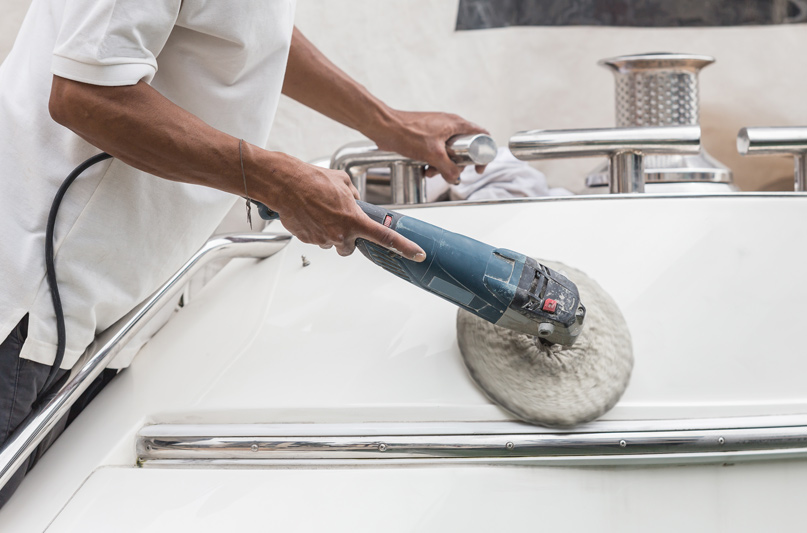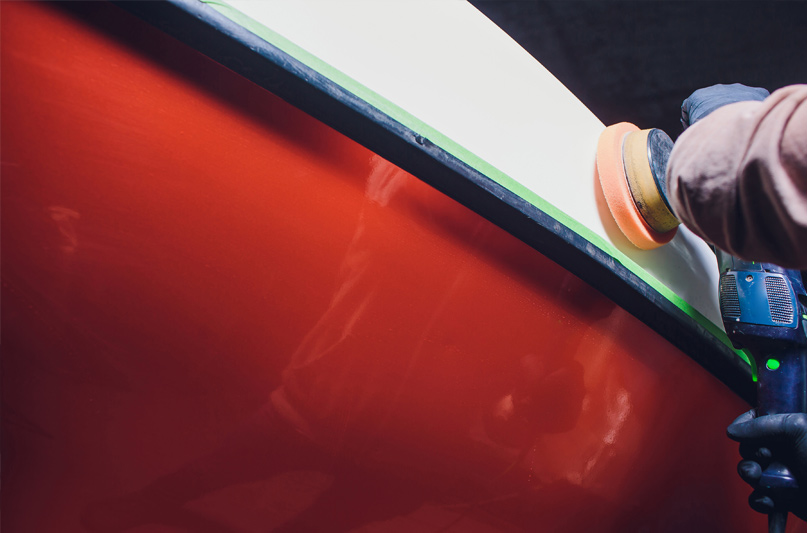“Let the beauty we love be what we do.”
– Jalal al-Din Rumi
 Let’s face it; when we look good, we feel good. Whether you’re fresh off the barber’s chair with a sharp new hair cut or just slipped into that little black dress saved for special occasions, it doesn’t do to neglect the aesthetic details when trying to put your best foot forward. What style and hygiene are to us, detailing is to our boats. Sure, we need to concern ourselves with keeping the boat afloat, the engine purring, sails in one piece, etc. But here in the Pacific Northwest, neglected boats don’t just look bad, they grow moss!
Let’s face it; when we look good, we feel good. Whether you’re fresh off the barber’s chair with a sharp new hair cut or just slipped into that little black dress saved for special occasions, it doesn’t do to neglect the aesthetic details when trying to put your best foot forward. What style and hygiene are to us, detailing is to our boats. Sure, we need to concern ourselves with keeping the boat afloat, the engine purring, sails in one piece, etc. But here in the Pacific Northwest, neglected boats don’t just look bad, they grow moss!
While the do-it-yourself spirit is part of what makes boat ownership an adventure, there’s a lot more to proper boat detailing than the occasional brush and hose treatment. Doing it right is a whole job unto itself, precious hours you may want to spend enjoying your ride. Our area is fortunate to have many businesses completely devoted to keeping your boat looking its best, often at reasonable prices. Look at it this way; a reliable boat detailer will always be cheaper than having to get a new paint job because a gelcoat was damaged through neglect.
To explore the nuances of boat detailing, we turn to professional Tammara Dinkins, founder and owner of Elliott Bay-based Splash N’ Detail. She shares some of her hard-won experience gleaned from over 20 years in the business with plenty of useful insights.
NWY: Boat detailing is a pretty big umbrella term. How would you define detailing in the context of boating?
This is a good question. Detailing refers more to the polishing and waxing side of a yacht’s maintenance. When we do a full detail, the yacht is getting a wash, then a polish and wax, the metal polished, the vinyl cleaned and conditioned, the nooks and crannies cleaned, etc.
NWY: What are your most common boat detailing projects and why do you think that is?
Our most common detailing projects are full details. Our clientele is meticulous and want their yachts to maintain that “like new” shine year-round. The reason for this is not just to look good either. When you have a good protective coat on the exterior finish, the yacht is easier to clean. It also keeps the finish from degrading in the UV (sunlight) and other elements.
Boats that never get waxed actually start to lose microlayers of gelcoat. Overtime, the gelcoat will get to a non-restorable point and have to be painted. This can decrease the value of the yacht when it comes time to sell it.
Another reason why detailing is important is that it puts a second set of eyes on your vessel that may catch things that the owner has not seen. For example, we find loose screws in railings, stress cracks in the finish, or rigging that may even need more than a polish or cleaning.
NWY: What does a comprehensive professional wash and interior clean look like? What are the steps involved and how does it differ from an amateur job?
A professional wash job is one where wash mitts are used on all areas within reach. Small detail brushes are used to clean crevices and around stanchions and drains. A soft blue brush is used to clean hard-to-reach areas and a brush with stiffer bristles is used for non-skid deck areas. If it is not raining, of course, surfaces are squeegeed and shammied and dried to prevent water spotting. An amateur job is taking a brush and just brushing off the dirt and rinsing off the boat. Brushes don’t really get the surface as clean as a microfiber wash mitt. They can also scratch the surface if used improperly.
A professional interior clean on a runabout includes deep cleaning the vinyl cushions and conditioning them. All cushions are pulled up and compartments are cleaned underneath. Carpets are shampooed, and synthetic flooring is cleaned really well. Dashes are cleaned with a variety of small brushes to get dirt and dust out from around gauges and vents, behind steering columns, and in cup holders. Windows are cleaned and buffed inside and out, and smooth finishes are coated with the appropriate protectants.
On yachts with full cabins, staterooms, and galleys, the interior is cleaned with household cleaners (preferably more organic or natural cleaners like Mrs. Meyers). Carpets, rugs, and upholstery can be steam cleaned or shampooed upon request, otherwise they are vacuumed. Heads are cleaned with the appropriate cleaners. We always ask if the yacht has an onboard sewage treatment system since normal head cleaners cannot be used in these systems. Shower stalls and fixtures are sometimes polished, in addition to being cleaned.
Windows are cleaned inside and out with a non-ammonia window cleaner. We like the Spray Away brand. You can find it at Fred Meyer or Costco and most major grocery or hardware stores. Floor boards are pulled up where possible and cleaned underneath. Wood surfaces are all wiped down. We have a few varieties of wood cleaners we use, depending on the finish. For high gloss finishes we use a vinegar water mix to avoid leaving any oily residue. Murphy’s (Oil Soap) Wood Cleaners are good on matte finishes. Guardsman makes a wood conditioner with UV additives that is popular as well.
NWY: Polishing and waxing can be a complicated business with different materials and compounds to consider. What are some pro tips when it comes to polishing and waxing? What factors are considered?
It is a bit overwhelming as a consumer standing in front of the myriad of polishes and waxes that profess to miraculously restore your yacht’s finish. Every detailer has their favorite mix that works for them. I will say there is not a miracle product out there, that I know of, that does not require some elbow grease to get professional results.
I have been a 3M fan since day one. Their compounds really get the job done and have been proven in the automobile industry and the marine industry. Most professional yacht painters that I know use their products to do the final polish on a paint job. One-step cleaner waxes have their use in the detailer’s tool box and can make a finish look okay for a while. We rarely use one-step products and when we do, we are usually using them in between the fall and spring details to get scuff marks off or remove exhaust residue. If you do use them, they still should be followed with a genuine carnauba or polymer protective coating.
When we polish out a yacht, we almost always use a polish first, like Finesse-it II or Perfect-It finishing compound, depending on the condition of the finish, before we apply the wax. What makes detailing an art is that there is not a recipe that works across the board for every boat. We have a variety of compounds that we use depending on the condition of the boat. If the boat is really oxidized, it may require two or three levels of compound before the final polish, and then the wax. If you want to maintain your own finish, I recommend talking to a professional company like ours and get some recommendations for your boat. If you have a boat that is severely oxidized, I would hire a professional to restore the finish for you, then you can carry on the maintenance from there.
NWY: Can you recommend a weekly, monthly, and annual “to do” or “chore list” that boaters should consider when it comes to detailing?
Most of our clients have us wash their boats once a month and get detailed annually. The clients that want their yacht in top shape have us wash the boat every other week and we wax the entire yacht annually and then do another wax on the superstructure (deck up) about six months later. A few have us wax the entire boat twice a year. We strive to meet the individual needs of our clients and create a program that works for them.

In addition to the waxing and washing, canvas should be cleaned and waterproofed annually or at least every two years. Canvas enclosures are expensive and if maintained, can last up to ten years before full replacement is necessary. Engine rooms and bilges should be cleaned annually as well. Whether you do this yourself or hire it out, it helps the owner see if anything unusual is going on. It is better to see leaks, check hoses, and, of course, keep nasties from entering our environment.
NWY: Teak is about as beautiful as it comes but the maintenance intimidates a lot of boaters. What are your thoughts about teak and what it takes to keep it gorgeous?
Teak is beautiful, but it is high maintenance. It has to be constantly cleaned in our damp Pacific Northwest environment. Annual cleaning with a mild teak cleaner is best. In my 19 years in the industry, I have learned that everyone from mega-yacht captains to small sailboat owners have a different method for maintaining teak.
Only one rule is steadfast, and that is you do not scrub raw teak with the grain or with stiff brushes. Use a Scotch-Brite™ and go against the grain of the wood. If you do have to go with the grain, go very lightly. If you want that gorgeous blonde look, you will have to use cleaners that are harsher and can wear the teak down faster than leaving the deck to gray out. Avoid letting the teak get green to the point where actual moss and lichens are growing in it. The usual winter green of the Pacific Northwest should be cleaned every spring. Teakdecking Systems makes a nice eco-friendly cleaner. It will leave the teak a nice natural brown, not blonde, but it works well and won’t hurt more sensitive paint finishes.
NWY: What does an engine room detailing project look like? Why is it important?
Engine room detailing involves cleaning the bilges, replacing oil absorbs, wiping down hoses, wiping down the engines, generators, walls, ceilings, etc. This is a very time consuming task.
NWY: What do you enjoy most about your job?
The people we work for are great. I love taking an older finish and turning it into a “like new” finish and seeing the joy on the owner’s face. It is hard, backbreaking work but very rewarding. We are always busy. April and May are the real crazy months. Most people think they are ahead of the game if they are calling us in May. We start scheduling our clients that have been with us for many years six months ahead of when they want the boat done. They have priority as well as our partners at Pacific Yacht Management. We have a good crew and are always looking for new talent to join!

